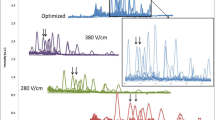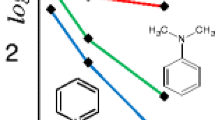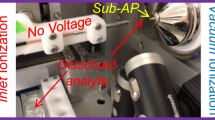Abstract
The present work highlights the effect that solvent chemistry has on analytes being detected when utilizing electrospray ionization in ion mobility mass spectrometers. Various studies were conducted involving both positive and negative mode ionization. The enhancements observed by utilizing different levels of acid modifiers as well as the different ionic species of analytes being formed and detected are presented. The makeup of the electrospray solvent determined whether the ionic species would be protonated, sodium adducted, ammonium adducted, proton abstracted or chlorinated. Addition of solvent modifiers such as acids in the positive mode, and organic halides in the negative mode improved signal strength of analytes as well as improved spray characteristics that also decreased signal variability. The ability to perform simultaneous ionization of complex mixtures was also demonstrated through the use of solvent modifiers thereby allowing electrospray ionization ion mobility mass spectrometry the ability to simultaneously analyze complicated mixtures very quickly (millisecond separations).










Similar content being viewed by others
References
Dole M, Mack LL, Hines RL, Mobley RC, Fergusan LD, Alice MB (1968) Molecular beams of macroions. J Chem Phys 49:2240–2249
Griffiths WJ, Jonsson AP, Liu S, Rai DK, Wang Y (2001) Electrospray and tandem mass spectrometry in biochemistry. J Biochem 355:545–561
Fenn JB (2002) Electrospray ionization mass spectrometry: how it all began. J Biomol Tech 13:101–118
Gieniec J, Cox HL, Teer D, Dole M (1972) Application of the ion-drift spectrometer to macromass spectrometry twentieth annual conference on mass spectrometry and applied topics. 276
Wittmer D, Luckenbill BK, Hill HH, Chen YH (1994) Electrospray-ionization ion mobility spectrometry. Anal Chem 66:2348–2355
Budnik BA, Tsybin YO, Hakansson P, Zubarev RA (2002) Ionization energies of multiply protonated polypeptides obtained by tandem ionization in Fourier transform mass spectrometers. J Mass Spectrom 37:1141–1144
Reid Asbury G, Klasmeier JR, Hill J (2000) Analysis of explosives using electrospray ionization/ion mobility spectrometry (ESI/IMS). Talanta 50:1291–1298
Khayamian T, Jafari MT (2007) Design for electrospray ionization-ion mobility spectrometry. Anal Chem 79:3199–3205
Tam M, Hill HH (2004) Secondary electrospray ionization-ion mobility spectrometry for explosive vapor detection. Anal Chem 76:2741–2747
Wu C, Siems WF, Hill HH (2000) Secondary electrospray ionization ion mobility spectrometry/mass spectrometry of illicit drugs. Anal Chem 72:396–403
Kebarle P, Verkerk UH (2009) Electrospray: from ions in solution to ions in the gas phase, what we know now. Mass Spectrom Rev 28:898–917
Amad MH, Cech NB, Jackson GS, Enke CG (2000) Importance of gas-phase proton affinities in determining the electrospray ionization response for analytes and solvents. J Mass Spectrom 35:784–789
Asbury GR, Wu C, Siems WF, Hill HH (2000) Separation and identification of some chemical warfare degradation products using electrospray high resolution ion mobility spectrometry with mass selected detection. Anal Chim Acta 404:273–283
Jafari MT, Rezaei B, Javaheri M (2011) A new method based on electrospray ionisation ion mobility spectrometry (ESI-IMS) for simultaneous determination of caffeine and theophylline. Food Chem 126:1964–1970
Tomlinson WJ (1977) Wavelength multiplexing in multimode optical fibers. Appl Opt 16:2180–2194
Leito I, Herodes K, Huopolainen M, Virro K, Kunnapas A, Kruve A, Tanner R (2008) Towards the electrospray ionization mass spectrometry ionization efficiency scale of organic compounds. Rapid Commun Mass Spectrom 22:379–384
Holcapek M, Jirasko R, Lisa M (2010) Basic rules for the interpretation of atmospheric pressure ionization mass spectra of small molecules. J Chromatogr A 1217:3908–3921
Puton J, Nousiainen M, Sillanpaa M (2008) Ion mobility spectrometers with doped gases. Talanta 76:978–987
Cole RB, Zhu JH (1999) Chloride anion attachment in negative ion electrospray ionization mass spectrometry. Rapid Commun Mass Spectrom 13:607–611
Cole RB, Harrata AK (1993) Solvent effect on analyte charge-state, signal intensity, and stability in negative-ion electrospray mass-spectrometry–implications for the mechanism of negative-ion formation. J Am Soc Mass Spectrom 4:546–556
Cai Y, Cole RB (2002) Stabilization of anionic adducts in negative ion electrospray. Mass Spectrom Anal Chem 74:985–991
Yinon J, McClellan JE, Yost RA (1997) Electrospray ionization tandem mass spectrometry collision-induced dissociation study of explosives in an ion trap mass spectrometer. Rapid Commun Mass Spectrom 11:1961–1970
Ewing RG, Atkinson DA, Eiceman GA, Ewing GJ (2001) A critical review of ion mobility spectromtetry for the detection of explosives and explosive related compounds. Talanta 54:515–529
Song LG, Wellman AD, Yao HF, Bartmess JE (2007) Negative ion-atmospheric pressure photoionization: electron capture, dissociative electron capture, proton transfer, and anion attachment. J Am Soc Mass Spectrom 18:1789–1798
Dillard JG (2002) Negative ion mass spectrometry. Chem Rev 73:589–643
Tang XT, Bruce JE, Hill HH (2006) Characterizing electrospray ionization using atmospheric pressure ion mobility spectrometry. Anal Chem 78:7751–7760
Straub RF, Voyksner RD (1993) Negative ion formation in electrospray mass spectrometry. J Am Soc Mass Spectrom 4:578–587
Hunter EP, Lias SG (2012) In: NIST chemistry WebBook, NIST standard reference database number, proton affinity evaluation, 69th edn. National Institute of Standards and Technology, Gaithersburg, MD
Remko M (1992) Theoretical study of proton affinities of some a/-bases of biological importance. Chem Papers 47:69–71
Author information
Authors and Affiliations
Corresponding author
Rights and permissions
About this article
Cite this article
Holness, H., Almirall, J. Speciation effects of solvent chemistry on the analysis of drugs and explosives by electrospray ion mobility mass spectrometry. Int. J. Ion Mobil. Spec. 16, 237–246 (2013). https://doi.org/10.1007/s12127-013-0136-2
Received:
Revised:
Accepted:
Published:
Issue Date:
DOI: https://doi.org/10.1007/s12127-013-0136-2




